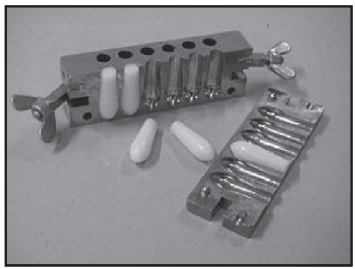Suppositories can be prepared by one of three methods:
1. Hand Rolling
• It is the simplest and oldest method of suppository
preparation and may be used when only a few suppositories are to be prepared in
a cocoa butter base. It has the advantage of avoiding the necessity of heating
the cocoa butter.
• By triturating grated cocoa butter and active ingredients
in a mortar a plastic-like mass is prepared. The mass is formed into a ball in
the palm of the hands, then rolled into a uniform cylinder with a large spatula
or small flat board on a pill tile. The
cylinder is then cut into the appropriate number of pieces which are rolled on
one end to produce a conical shape.
• The suppository "pipe" or cylinder tends to crack
or hollow in the centre, especially when the mass is insufficiently kneaded and
softened.
2. Compression Molding
Compression moulding is a method of preparing suppositories
from a mixed mass of grated suppository base and medicaments which is forced
into a special compression mould using suppository-making machines. The
suppository base and the other ingredients are combined by thorough mixing. The
base softens because of the friction in the process. A mortar and pestle can be used on a small
scale. On the other hand, large-scale manufacturing involves mechanically
operated kneading mixers and a warmed mixing vessel. In the compression machine, the suppository
mass is placed into a cylinder which is then closed. After that from one end
pressure is applied to release the mass from the other end into the suppository
mould or die. When the die is filled with the mass, a movable end plate at the
back of the die is removed and when additional pressure is applied to the mass
in the cylinder, the formed suppositories are ejected. The end plate is
returned, and the process is repeated until all of the suppository mass has
been used. When active ingredients are added, it is necessary to omit a portion
of the suppository base, based on the density factors of the active
ingredients.
3. Fusion Moulding
The Fusion Moulding process involves the following
steps:
• Firstly melting the suppository base.
• Then the drug is either dispersed or dissolved in the
melted base.
• The mixture is then removed from the heat and poured into a
suppository mould.
• The melt is allowed to congeal.
• Now the suppositories are removed from the mould.
Suppository Moulds
Small-scale moulds are capable of producing 6 or 12
suppositories in a single operation.
Industrial moulds produce thousands of suppositories per hour from a
single moulding.
Calibration of the Mould
The calibration of mould is necessary because the size of the
suppositories remains the same from a particular mould but their weight varies
because the density of the different types of bases and the medicaments used
are different. The first step is to prepare moulded suppositories from the base
material alone. The suppositories are combined and the average weight is
recorded. To determine the volume of the mould, the suppositories are melted in
a calibrated beaker, and the volume of
the melt is determined.
Lubricants used in Mould
Cocoa butter and glycero-gelatine bases are required
lubrication of moulds. This prevents the sticking of bases to the wall of the mould
cavity. It is also useful in the easy removal of suppositories from the moulds.
The lubricants form a film between the wall of the mould cavity and the base of
suppositories so, it prevents the adhering of bases to the moulds. The nature
of lubricants should be different from the nature of bases.
Lubricant must be compatible with medicament or adjuncts. In
industry, silicone fluid is used as a lubricant. Mould is lubricated using a
pad of gauze or muslin or with a small fairly stiff brush. Cotton wool is not
used because some fibres adhere to the mould. Excess lubricant can be removed
by inverting the mould on a clean white tile.
Following lubricants may be used for the preparation of
theobroma oil suppositories.
Examples:
(a) For cocoa butter bases
Alcohol(90%)- 50 ml
Glycerol - 10 ml
Soft soap - 10 gm
(b) For glycerol-gelatin base
Liquid paraffin or Arachis oil is used as a lubricant.
Packaging
Suppositories must be packed in such a manner that they do
not touch each other.
Poorly wrapped and packaged suppositories can lead to
staining, breaking or deformation by melting caused by adhesion. Suppositories
usually are foiled in tin or aluminium, paper or plastic strips. Overwrapping
is done by hand or machine.
Hand packing yields a non-uniform product so machines are
utilised to overcome this problem and machines can wrap 8000 suppositories per
hour.
Storage
Suppositories should be protected from heat, preferably by
storing in the refrigerator.
Polyethylene glycol suppositories and suppositories enclosed in a solid
shell are less prone to distortion to temperature slightly above body
temp.
Labelling
Suppositories should be labelled as:
(a) "STORE IN A COOL PLACE"
(b) "FOR EXTERNAL USE ONLY"
(c) "NOT TO BE TAKEN ORALLY".

